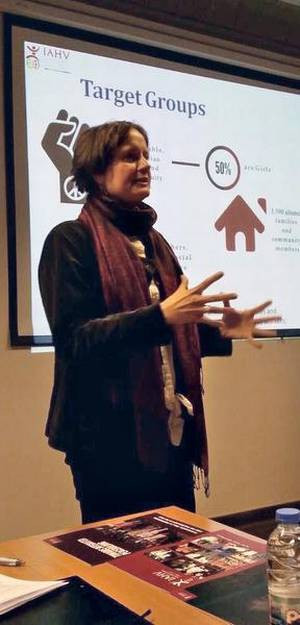Katrien Hertog believes that peace-building efforts are incomplete without taking into account the hearts and the minds of those involved in the conflict

Katrien Hertog, a peace-building researcher, was doing her Ph.D in the field, studying deeper layers of peace-building when she stumbled upon Indian spirituality and breathing techniques. She realised that this was the missing element in the approach to existing peace building models. “I have been working in this space for over 20 years, with different organizations. When I did the Art of Living programme, I wanted to integrate the knowledge and the techniques into peace building,” says Katrien, during a visit to Bengaluru.
“Peace-building, internationally, has been focused on creating systems and structures and does not really look into the people — those who are driving the conflict and those affected by it. They think that if we increase development, boost economy, create structures for justice and security, then peace will come.”
What really needs to be done, she points out, is to work on the hearts and the minds of people. “Whatever else you do can’t be sustained because it can’t be internalised. What Art of Living offers is powerful and effective, it can be done by huge numbers of people at the same time, unlike counselling which is done one-on-one and is practically not possible keeping in mind the millions of people affected.”
The techniques taught in the programme are centred around the Sudarshan Kriya, the highlight of the programme, as well as age-old techniques of yoga, pranayama and meditation. The programme is in the process of reaching out to over 18,000 children affected by the war, over 3000 refugees in the Middle-Eastern regions of Lebanon and Jordan and over 20,000 Iraqi citizens.
“We are focusing on preventing and transforming extremism (and radicalisation) both in Europe and in the Middle-East. We are working with mothers whose children fought in the Syrian war, youth who have been radicalised in Europe and the Syrian youth who are returning from the field. The lives of these people, especially the children are permeated with violence. We are working to root out the potential of self-harm and substance abuse among them,” explains Katrien who is leading the programme for the International Association of Human Values (IAHV).
The association has been on the front lines in conflict zones helping rehabilitate survivors through non-violent empowerment and psycho-social engagement activities.
“We are also working to build relationships between refugees and host populations.”
Katrien works closely with other professional peace-building organisations, training personnel who are working on the front lines in stress-management techniques to prevent burnout.
“There was scepticism on doing yoga in the war zone. We needed to develop an approach that could be integrated into the existing peace building models and it has happened. Since last year, the going has been easier. There is more awareness in the international community because their efforts have not been sustainable so far and people are looking for newer, more innovative approaches.”
The organisation was also recently invited to an expert meeting in South Africa which carried a review of 150 organisations working in the field.
“The panel mentioned that IAHV was the only organization in the world that integrated peace building, mental health, and psychosocial support. Five years ago, we would not have been invited to such meetings.”
Katrien’s team (of six trainers) began by working in the regions in Lebanon and Jordan that have been worst hit by the conflict.
“We scout to see where help is most needed. We have projects managers who have been there for a few years, building relationships on all sides of the conflict, gaining the people’s trust. They also monitor the security situation and intimate the trainers. It takes a lot of patience to remain truly neutral and have a humane approach.”
In Lebanon, they went to a city in the North that was described as a ticking bomb with tensions between Shias and Sunnis and a huge influx of refugees.“In Jordan, we work differently, partnering with local organisations who work with vulnerable and marginalised refugees, especially children, teachers and parents. We also train the staff in these organisations so they can offer some of these techniques to the people they are working with.”
One of the most important aspects of the peace-building program in this part of the Middle-East is boosting the self-confidence of the youth, both local and from the refugee camps.
“We give them the self-confidence to be who they want to be without peer pressure and create an alternative community for them. Research has established that young people join extremist groups for the same reason they join gangs.” Katrien’s team has designed a Youth leadership Peacebuilding Training (YLPT) programme to handle this tendency. “Here they learn how to deal with conflict in different ways, learn about peace-building, analyse the violence that has been unfolding in their environment and make plans. We want to channelize the frustration of the youth into something positive.”
So far, the team has conducted two such youth leadership programmes in Jordan, which successfully brought together a mix of Syrians and Jordanians, in order to eliminate the conflict between them. “Gradually, through these programmes, we want to set up projects to reduce violence in schools, communities and camps. We need to break the vicious cycle of violence,” she explains.
“Now we need more trainers because there are millions who are affected and their needs are urgent. Even though we have reached out to a few thousands, we need to make a bigger impact. We have the knowledge and the expertise to make it happen, we have no difficulty in connecting with the people. For that, we need more human resources and more financial resources.” They have begun this process by offering training programmes for professionals who are already on the field.
Courtesy: The Hindu